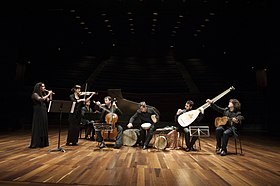
Historically informed performance (also referred to as period performance, authentic performance, or HIP) is an approach to the performance of classical music which aims to be faithful to the approach, manner and style of the musical era in which a work was originally conceived.
It is based on two key aspects: the application of the stylistic and technical aspects of performance, known as performance practice; and the use of period instruments which may be reproductions of historical instruments that were in use at the time of the original composition, and which usually have different timbre and temperament[1] from their modern equivalents. A further area of study, that of changing listener expectations, is increasingly under investigation.[2]
Given no sound recordings exist of music before the late 19th century, historically informed performance is largely derived from musicological analysis of texts. Historical treatises, pedagogic tutor books, and concert critiques, as well as additional historical evidence, are all used to gain insight into the performance practice of a historic era. Extant recordings (cylinders, discs, and reproducing piano rolls) from the 1890s onwards have enabled scholars of 19th-century Romanticism to gain a uniquely detailed understanding of this style, although not without significant remaining questions. In all eras, HIP performers will normally use original sources (manuscript or facsimile), or scholarly or urtext editions of a musical score as a basic template, while additionally applying a range of contemporaneous stylistic practices, including rhythmic alterations and ornamentation of many kinds.[1]
Historically informed performance was principally developed in a number of Western countries in the mid to late 20th century, ironically a modernist response to the modernist break with earlier performance traditions.[3] Initially concerned with the performance of Medieval, Renaissance, and Baroque music, HIP now encompasses music from the Classical and Romantic eras. HIP has been a crucial part of the early music revival movement of the 20th and 21st centuries, and has begun to affect the theatrical stage, for instance in the production of Baroque opera, where historically informed approaches to acting and scenery are also used.[4][1]
Some critics contest the methodology of the HIP movement, contending that its selection of practices and aesthetics are a product of the 20th century and that it is ultimately impossible to know what performances of an earlier time sounded like. Obviously, the older the style and repertoire, the greater the cultural distance and the increased possibility of misunderstanding the evidence. For this reason, the term "historically informed" is now preferred to "authentic", as it acknowledges the limitations of academic understanding, rather than implying absolute accuracy in recreating historical performance style, or worse, a moralising tone.[5][4]
- ^ a b c Lawson & Stowell 1999, p. 17-18.
- ^ Bonds, Mark Evan (2006). Music as Thought. Princeton: Princeton University Press. ISBN 978-0-691-12659-3.
- ^ Taruskin, Richard (1995). Text & Act: Essays on Music and Performance. Oxford: Oxford University Press.
- ^ a b Hunter, Mary (2014). "27. Historically informed performance". In Greenwald, Helen M. (ed.). The Oxford Handbook of Opera. Oxford University Press. pp. 606–8. ISBN 978-0-19-971484-1. Archived from the original on 20 August 2023. Retrieved 3 March 2018.
- ^ Fabian, Dorottya (1 December 2001). "The Meaning of Authenticity and The Early Music Movement: A Historical Review". Retrieved 3 March 2018.